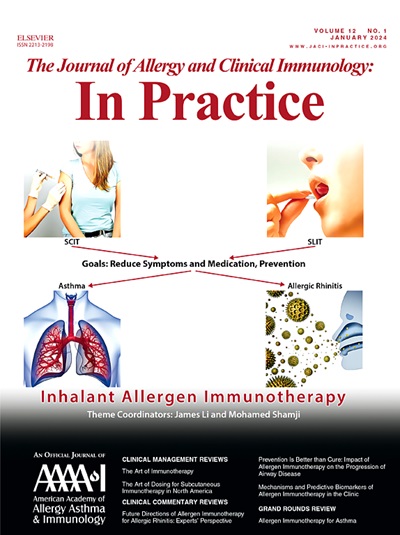在嗜酸性粒细胞过多综合征患者中使用杜匹单抗:多中心病例系列和文献综述。
IF 6.6
1区 医学
Q1 ALLERGY
Journal of Allergy and Clinical Immunology-In Practice
Pub Date : 2025-01-01
DOI:10.1016/j.jaip.2024.10.036
引用次数: 0
摘要
背景:嗜酸性粒细胞过多综合征(HES)是指嗜酸性粒细胞过多并伴有嗜酸性粒细胞相关临床表现,其中一些表现与哮喘、特应性皮炎、嗜酸性粒细胞食管炎和/或慢性鼻炎伴鼻息肉(CRSwNP)重叠。杜比鲁单抗已被批准用于治疗这些疾病,但它会引起嗜酸性粒细胞绝对计数(AEC)的短暂升高和罕见的嗜酸性粒细胞相关并发症:目的:确定嗜酸性粒细胞相关并发症在HES中是否增加:方法:对在美国国立卫生研究院(NCT00001406)接受 IRB 批准的研究方案治疗或在沃尔特里德国家军事医疗中心接受治疗的 HES 患者进行回顾性病历审查。记录了临床反应和治疗突发不良事件。使用储存样本对部分患者在使用杜匹单抗前后的血清介质进行了评估:在28名患者(15名男性,13名女性;中位年龄41.5岁)中,杜比单抗最常见的处方适应症是CRSwNP(11人)。23名患者(82%)在使用杜必鲁单抗后临床症状明显改善。9/20的患者在接受杜比单抗单药治疗后嗜酸性粒细胞过多症(AEC>1.5x109/L)复发或恶化。此外,4/20(20%)名患者在停用杜比单抗和/或增加嗜酸性粒细胞降低疗法后出现了嗜酸性粒细胞相关并发症。在接受降低嗜酸性粒细胞生物制剂治疗后血液学症状缓解的 8 位患者中,没有人出现嗜酸性粒细胞过多或嗜酸性粒细胞相关并发症。接受杜比单抗治疗后,血清 IgE 和 eotaxin 水平下降:这些数据表明,杜普鲁单抗能有效治疗 HES 患者的残余症状,但嗜酸性粒细胞相关并发症的发生率会增加。在HES患者接受杜比单抗治疗期间,同时进行嗜酸性粒细胞降低治疗可降低嗜酸性粒细胞相关并发症的风险。本文章由计算机程序翻译,如有差异,请以英文原文为准。
Dupilumab Use in Patients With Hypereosinophilic Syndromes: A Multicenter Case Series and Review of the Literature
Background
Hypereosinophilic syndromes (HES) are defined as hypereosinophilia with eosinophil-related clinical manifestations, some of which overlap in presentation with asthma, atopic dermatitis, eosinophilic esophagitis, and/or chronic rhinosinusitis with nasal polyps. Dupilumab is approved to treat these conditions but can induce a transient rise in the absolute eosinophil count and rare eosinophil-related complications.
Objective
To determine whether eosinophil-related complications of dupilumab are increased in HES.
Methods
Retrospective chart review of patients with HES treated with dupilumab enrolled on an institutional review board–approved research protocol at the National Institutes of Health (NCT00001406) or receiving care at Walter Reed National Military Medical Center. Clinical response and treatment-emergent adverse events were recorded. Serum mediators were assessed in a subset of patients before and after dupilumab using stored samples.
Results
Among the 28 patients (15 male, 13 female; median age 41.5 y), the most common prescribing indication for dupilumab was chronic rhinosinusitis with nasal polyps (n = 11). Twenty-three patients (82%) showed significant clinical improvement on dupilumab. Hypereosinophilia (absolute eosinophil count > 1.5 × 109/L) recurred or worsened in 9 of 20 patients on dupilumab monotherapy. Moreover, 4 of 20 (20%) patients developed an eosinophil-related complication with dupilumab discontinuation and/or addition of eosinophil-lowering therapy. None of the 8 patients who received dupilumab while in hematological remission on an eosinophil-lowering biologic developed hypereosinophilia or an eosinophil-related complication. Serum immunoglobulin E and eotaxin levels decreased on dupilumab therapy.
Conclusions
These data suggest that dupilumab is effective in treating residual symptoms in HES patients but that the incidence of eosinophil-related complications is increased. Concomitant eosinophil-lowering therapy may reduce the risk of eosinophil-related complications during dupilumab therapy in patients with HES.
求助全文
通过发布文献求助,成功后即可免费获取论文全文。
去求助
来源期刊

Journal of Allergy and Clinical Immunology-In Practice
ALLERGYIMMUNOLOGY-IMMUNOLOGY
CiteScore
11.10
自引率
9.60%
发文量
683
审稿时长
50 days
期刊介绍:
JACI: In Practice is an official publication of the American Academy of Allergy, Asthma & Immunology (AAAAI). It is a companion title to The Journal of Allergy and Clinical Immunology, and it aims to provide timely clinical papers, case reports, and management recommendations to clinical allergists and other physicians dealing with allergic and immunologic diseases in their practice. The mission of JACI: In Practice is to offer valid and impactful information that supports evidence-based clinical decisions in the diagnosis and management of asthma, allergies, immunologic conditions, and related diseases.
This journal publishes articles on various conditions treated by allergist-immunologists, including food allergy, respiratory disorders (such as asthma, rhinitis, nasal polyps, sinusitis, cough, ABPA, and hypersensitivity pneumonitis), drug allergy, insect sting allergy, anaphylaxis, dermatologic disorders (such as atopic dermatitis, contact dermatitis, urticaria, angioedema, and HAE), immunodeficiency, autoinflammatory syndromes, eosinophilic disorders, and mast cell disorders.
The focus of the journal is on providing cutting-edge clinical information that practitioners can use in their everyday practice or to acquire new knowledge and skills for the benefit of their patients. However, mechanistic or translational studies without immediate or near future clinical relevance, as well as animal studies, are not within the scope of the journal.
 求助内容:
求助内容: 应助结果提醒方式:
应助结果提醒方式:


